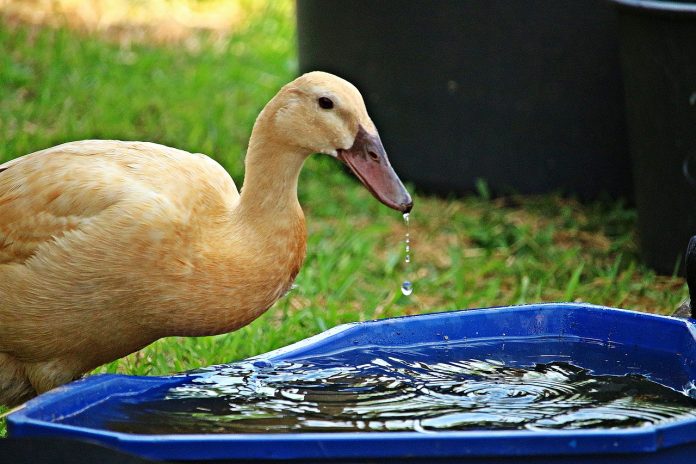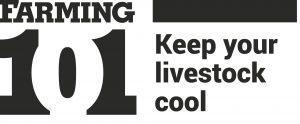1Dairy Cattle
Dairy cows start to experience mild heat stress at a heat index of about 68 degrees. They need water (a 1,500-pound dairy cow producing 80 pounds of milk per day will drink 33 gallons of water a day in 80-degree weather); shade; fans; sprinklers (just not over the stall beds, as the increased moisture can contribute to mastitis); misters; or tunnel ventilation with cooling cells (smaller barns). Focus on the holding pen and milking parlor.
Talk to your nutritionist about changing the ration to decrease heat produced by fermentation. And pay attention to your fresh cows because they’re more susceptible to heat stress.
2Beef Cattle
Typically pastured cattle are not as susceptible to heat stress as feedlot cattle or cattle confined to a barn.
Cattle should not be worked during times of extreme heat and only early in the morning when it is hot. Don’t work them in the evening even if it has cooled off a little — that’s because a cattle’s core temperature peaks 2 hours after peak environmental temperature. It also takes at least 6 hours for cattle to dissipate their heat load.
Consumption of water is the quickest method for cattle to reduce their core body temperature. Rule of thumb is that cattle need 3 inches of linear water space per head during the summer, so add extra water tanks prior to extreme heat events so that cattle become accustomed to them. And keep the tanks clean.
Cattle heat production from feed intake peaks 4 to 6 hours after feeding, which means heat production in cattle fed in the morning will peak in the middle of the day when environmental temperatures are also elevated. Not good. It’s recommended cattle receive a least 70 percent of their feed 2 to 4 hours after peak ambient temperature.
3Hogs
Pigs are much more sensitive to heat than other animals because they lack the ability to sweat. Signs of stress in pigs include: open-mouth breathing, vocalization, blotchy skin, stiffness, muscle tremors and the reluctance to move. If pigs begin to express signs like these, allow them to rest. It is also helpful to gently sprinkle cool water on the pig. Do not pour large amounts of cold water on the pig as this may send the pig into shock.
Additionally, it is important to provide shade for pigs housed outside.
4Sheep and goats
Sheep and goats tend to be less susceptible to heat stress than other livestock, and goats tend to tolerate heat better than sheep.
Wool protects sheep from extreme heat as well as extreme cold. Spring shearing allows sheep to have adequate wool growth to keep them cool in the summer (and avoid sun burning).
During periods of extended heat and humidity, it may be necessary to provide extra water and clean and change waterers more often. On average, a sheep or goat will drink one to two gallons of water per day.
5Horses
Horses have difficulty regulating their body temperature when temperatures exceed 90 degrees. If humidity is high, the temperature doesn’t even have to reach 90 degrees to become dangerous.
It’s important that your horse has access to cool, clean water at all times. Even non-working horses will double their water intake during hot weather. On average, a 1,100-pound horse consumes 4 to 9 gallons of water per day.
Fresh pasture contains between 60-80 percent moisture and provide a large amount of the horse’s water requirements when grazing. Hay and grain are very low in moisture, causing horses to drink more water to meet their needs.
Hot weather also increases horses’ need for salt, because they lose the mineral during sweating. Consider adding a few ounces of salt or an electrolyte supplements to horses’ diets if lack of water consumption is a concern.
6Poultry
The most obvious sign of heat stress in poultry is panting. Here’s what to do:
Make sure birds have cool, clean water, and consider adding electrolytes. Feed birds during cooler parts of the day, and since birds produce heat while they digest, for broilers and turkeys, remove feed 6 hours before the afternoon peak temperature. Once the peak temperature has passed, feed can be reintroduced.
Make sure the birds have plenty of space, and make sure housing is well-ventilated.
7Farm Dogs
And don’t forget your farm dog this summer. Give him a shady and well-ventilated spot outdoors, or even put a small kiddie pool in the yard and keep it filled.
Sources: American Association of Equine Practitioners; University of Kentucky College of Agriculture, Food and Environment; Michigan State University Extension; Penn State University Extension.
(Farm and Dairy is featuring a series of “101” columns throughout the year to help young and beginning farmers master farm living. From finances to management to machinery repair and animal care, farmers do it all.)
More Farming 101 columns:
- How to create an irrigation schedule
- How to choose the right irrigation system
- Things to consider when burning agricultural waste
- What can you burn on the farm?
- 9 tips for better pasture management
- 7 safety tips for driving farm equipment on the road
- 5 things to know about farmland leases
- No-till planter in-field checklist
- How to prep a no-till planter part 2
- How to prep a no-till planter
- 7 considerations for gardening with high tunnels
- 9 basic considerations for backyard poultry
- 9 ways to grow your farm business
- 10 questions to ask before expanding the farm
- How to select quality replacement heifers
- Stay safe working with electricity on the farm
- How to create a job safety analysis
- Tips for a successful lambing season
- Do you have a vision for your farm?
- Cattle handling for beginners
- Should I buy a new or used tractor?
- How to inspect a used tractor before purchase
- How to buy the right tractor for your farm
- 5 tips for a better farm marketing plan
- How to seek help with retirement planning
- How to set goals for retirement
- A farmer’s guide to saving for retirement
- A farmer’s guide to planning for retirement
- 5 steps to get NRCS assistance
- How can conservation easements help you?
- How to fund conservation plans
- What is a conservation plan?
- How can NRCS help you?
- More airborne hazards on the farm
- 5 airborne hazards to beware of on the farm
- 5 things to know about Wagyu beef
- Pennsylvania utility vehicle laws
- Ohio utility vehicle laws
- Farm chemical safety checklist
- When should a farm become a business entity?
- Harvest prep: Check your yield monitors
- How to tag livestock properly
- 6 tips for decision making on a family farm
- 8 tips to prepare your farm for agritourism
- How to plan for farm emergencies
- 7 keys to success on the farm
- 7 tips for healthy fair animals
- 5 tips to ensure livestock health before the fair
- 6 tips to keep your livestock parasite free
- 6 tips for vaccinating your livestock
- 5 tips to prevent dairy cow foot problems
- 6 common foot problems found in dairy cows
- Recognize, prevent heat stress in dairy cattle
- How to monitor your dairy herd
- How to start your own dairy farm
- 5 tips for sun safety in the field
- Employing youth for the summer
- What to do if a hay fire occurs
- How to prevent hay fires
- How to extend the life of your fence
- 10 safety tips for installing electric fences
- How to chose the right fence for your farm
- How to create a fencing plan
- 7 steps for easy sprayer calibration
- Prepare for planting season, Part 2: Calibration
- Prepare for planting season, Part 1: The Basics
- 7 tips to improve security on your farm
- 5 tips to protect your farmland
- 3 measures to deal with severe farm debt
- How to buy time to catch up on farm debt
- 6 tips to manage income on the farm
- 5 tips to recognize and deal with farm stress
- How to prepare a livestock birthing kit
- 5 tips for marketing your farm
- How to develop farm mission, vision statements
- 5 tips for setting farm goals
- 2 types of livestock insurance policies
- 6 things you need to know about WFRP plans
- 3 basics of crop insurance
- How does liability insurance work on the farm?
- Why do I need farm insurance?
- How to understand and use Ohio’s CAUV
- How to utilize the Pa. Clean and Green Act
- 9 tips for filing farm taxes
- 8 reasons record keeping for taxes is essential
- 5 tips for post-harvest storage
- 7 tips for family meetings on the farm
- 4 tips for balancing your farm and family
- 4 tips for communicating on the family farm
- 4 tips for firing an employee
- 6 tips for keeping good farm help
- 4 tips for recruiting farm labor
- 5 general farm labor laws
- 4 tips for employing minors
- 4 tips for PTO safety
- 5 things young farmers should know about finances
- The farm balance sheet
- 5 items for your farm’s cash flow statement
- Personal and business records: Keep them separate
- What to include in your farm business plan
- How to approach a lender: Tips for getting a farm loan
- How to use microloans to get your farm started
- Saving for the future: 6 tips for young farmers
- How to create a farm safety kit
- 5 tips for child safety on the farm
- 4 tips for transporting livestock
- 5 ways to better understand tractor stability
- 6 farm equipment hacks














